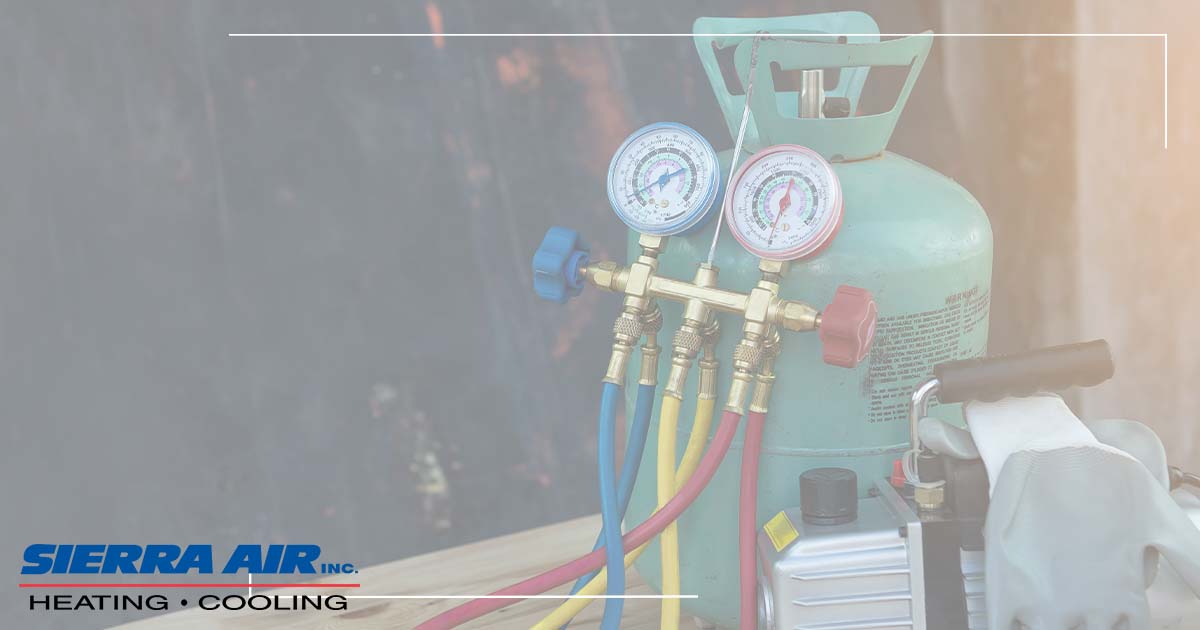On a hot summer day, homeowners rely on their air conditioners to provide respite indoors. This comfort comes to them through science or the AC refrigerant flowing inside the air conditioner. We’ll discuss what refrigerant is, the different types used then and now, and signs you may have a refrigerant leak.
What is Refrigerant?
Refrigerant is the chemical inside an air conditioner that changes its physical state under defined conditions, such as applying high pressure. During these changes is when the air conditioner creates cool air. Each air conditioner is charged or loaded with an amount of refrigerant appropriate for the overall unit size, such as how many square feet it can cool.
What are the Different Types of Refrigerants?
Chlorofluorocarbons (CFCs)
CFCs were the first non-flammable and non-toxic refrigerants used in air conditioners. They were banned from use in air conditioners in the early 1990s. Unfortunately, CFCs contribute substantially to greenhouse gasses in the atmosphere and the breakdown of the ozone layer.

R-22 Refrigerant
Developed in the 1950s and the standard air conditioner refrigerant for six decades, R-22 refrigerant differs from its predecessor through an added hydrogen atom. Though this atom shortens its environmental lifespan, R-22 was banned for use in new air conditioners in 2010 because of its ecological impact.
R-410A Refrigerant
Air conditioners built and installed after 2010 generally use R-410A refrigerant. Lacking a chlorine atom, this type is more eco-friendly and is commonly known as Puron. Puron absorbs and releases heat more efficiently and has a lower condensation temperature, reducing the electricity needed to cool your home. It was developed in the 1990s as companies looked for a replacement for CFCs.
R-32 Refrigerant
The newest type of air conditioner refrigerant, R-32, has a lower energy consumption than R-410A and, by extension, less of an environmental impact. Air conditioners charged with R-32 use almost 20% less refrigerant than even new systems with R-410A. Your air conditioner doesn’t have to cycle as often to provide the set temperature, lowering your electric bill.
How Does Refrigerant Work?
The air conditioner’s fan pulls hot air from the home and moves the air across the evaporator coils. These coils hold the liquid refrigerant, which absorbs the heat, and the refrigerant turns into a gas. The gas goes to the compressor as the system pushes cool air into the home. Inside the compressor, the gas pressure rises until it turns into liquid again in the condenser coil, and the cooling cycle starts over.
How Can I Check What Kind of Refrigerant My AC Uses?
If the system was built and installed before 2010, it probably uses R-22. Most units have a sticker on the outdoor condenser listing the type of refrigerant. The type should be noted in the user manual. You can also ask the HVAC technician during a maintenance appointment.
What Does it Mean to Recharge the Refrigerant?
Recharging an air conditioner adds more refrigerant until the system has the appropriate amount. It’s often done after repairing a leak and should only be done by an HVAC technician. This is because of the high-pressure levels; without the proper equipment, you have a substantial risk of damaging the air conditioner.
Signs Your AC Needs Refrigerant Work
Sometimes it’s easy not to realize your AC needs refrigerant work and believe the issue lies in a different part of the system. But, if you suspect or find the unit has a leak, never try to fix it yourself. Call an HVAC technician. They have the appropriate equipment and tools to protect you and the air conditioner since the refrigerant is harmful if ingested, inhaled, or touched.
AC is on, but no cool air is coming out
An AC with a low refrigerant level won’t absorb heat and humidity as usual. The result is only warm air, or less air, coming from your home’s air vents.

Higher than Usual or Increasing Electric Bills
Without the required amount of refrigerant to work efficiently, your air conditioner begins to cycle or run more frequently to compensate. Remember, the refrigerant absorbs warm air; without it, the unit tries to keep up with the thermostat temperature. More cycling means more electricity consumption and, thus, a higher electric bill.

Coils are Frozen
Though it sounds counterintuitive, the coils freeze when there isn’t enough refrigerant. The warm air flowing over them freezes as the cold refrigerant flows backward. When this happens, it’s imperative to repair the issue quickly, or the compressor could freeze and cause a complete system failure.
You haven’t had a tune-up in a while
These appointments allow an HVAC technician to give the entire air conditioner system a thorough look over and make repairs if necessary. If, for example, your AC has the beginnings of a refrigerant leak, the technician can fix the leak and recharge the unit before any significant damage occurs. Regular tune-ups help the AC extend its functional lifespan and operate efficiently.
The next time you’re relaxing in a comfortable air-conditioned home, thank the science behind the refrigerant flowing in the system.
If your air conditioner is low on refrigerant, or has any other issues, contact Sierra Air Inc., for reliable and professional HVAC service.




